Future of the feed/food industry: re-inventing animal feed
Challenges and opportunities facing the international feed/food industry have never been greater than those faced by these industries today. It has become apparent that anything less than a very proactive approach to addressing current challenges may not be sufficient. Current international events are leading feed companies to attempt to move from a traditional role as a ‘feed company’ to becoming an integral part of the ‘Food Supply Chain’. This is driven essentially by the fact that although one cannot ensure that food company products eaten by consumers are safe, as a prominent player in the early part of the food chain, it is essential that the feed industry ensure that the feedstuff supply chain is not the problem.
This new reality has led feed companies to initiation of the concepts of oversight, control, and overall security of their component of the food chain. Feed companies are, out of necessity, now becoming ‘Food Safety Guardians’. The commitment by the feed company to provide customers with products of the highest quality has been deemed vital to the success of the business. Therefore, feed companies must become early leaders in assuring that all products are Hazard Analysis and Critical Control Point (HACCP) certified. In addition, it is essential that feed companies become registered in the ISO 9001 quality standard or adopt a similar standard. HACCP is a systematic approach to identifying and preventing contamination of food and food products during the manufacturing process. ISO certification is an internationally recognized quality management system that emphasizes integrity throughout the manufacturing process, using standardized and verifiable procedures in all aspects of operations from product design through manufacturing and distribution. The same level of concern has progressed through the livestock and poultry production chain to include producers, integrators, processors, and retailers.
Three key issues asked of the industry today are 1) what are animals consuming, 2) how are animals being cared for, and 3) has the animal been sick? The traditional protein business chain from vegetable to animal protein has changed dramatically. Traditionally, this has been a production-based model from the farmer to the consumer with little oversight. The reality today is that the consumer is providing oversight to the retailer who then places constraints on the production chain to conform to specific standards of production. Overall confidence in food safety was down in the early 1990s, tended to rise and peaked in the mid 1990s and has declined since (Figure 1). 
Another issue being addressed by the multinational feed companies is globalization. Given all the issues being addressed internationally, specific feeds need to be modified to fit specific country labeling. This presents tremendous difficulties in developing branded products with international acceptance. Solutions to these issues are exacerbated by the multitude of regulatory hurdles that must be overcome. These include differences in the use of antibiotics, animal proteins, genetically modified materials, and feed additives. Companies that supply inputs are required to think as globally as processors and retailers.
These issues were in the implementation stage prior to the discovery of BSE in North America. All components of the feed/food industries are being affected by this discovery. This is leading to the rapid development and implementation of a national identification program in the US. The ID program will likely bring rapid adoption of Radio Frequency Identification Devices (RFID) in production and processing sectors of the food supply chain and will match the drive of Wal-Mart’s RFID technology in the retail sector. There will be public pressure for the US government to fund the development and implementation of the national animal ID program, perceived as essential for traceability in a comprehensive food safety program. The need for traceability has been the greatest cost impediment to the adoption and implementation of country-of-origin labeling (COOL). The Manitoba Pork Council has initiated a pilot swine traceability study as part of a national effort to identify the most cost efficient method of tracing swine movement in Canada.
The lack of qualified workers has been and continues to be a major constraint for those associated with the integrated livestock and poultry industries. A survey of students enrolled in swine production in the top swine-producing US states was conducted by Duane Reese (Table 1). This study indicates that interest among students had declined in 9 out of the top 10 swine-producing states over the last five years, with an average decline of 28% in the number of students enrolled. Many other states reported that a lack of interest among students is resulting in swine production not being offered or offered on alternate years. Similarly, poultry production is only offered by a limited number of universities and interest in a poultry production major is low. It is worth noting that this lack of interest comes at a time when world meat demands are expected to increase as developing countries have more disposable income, with a projected increase of 50% by the year 2025 (Elam, 2004). At the same time, the acreage of row crops is projected to decrease over that same time period. Thus, it is imperative to improve production efficiency in both the livestock and crop sectors to be able to meet the rising demands. The other huge area is the need to revamp production agriculture so that all components can be brought back to consistent profitability. 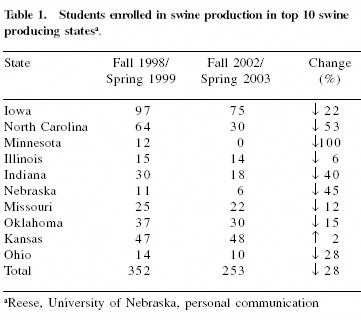
Evaluation for technology development by the livestock industry
The swine and poultry industries have made tremendous progress through the years in terms of genetics, nutrition, husbandry and health. Advances in production and management have provided the marketplace with a high volume, low cost animal protein. Historically the livestock industries have been mostly concerned about commodity production that works best in a least cost, most efficient production model. There are two schools of thought regarding technology evaluation for large systems.
The typical approach that has served the integrated livestock industry well in the past is the cost analysis system that is used by Agrimetrics and Agristats. The technique used is a comparison-based cost analysis that compares the cost-of-gain of one company with the cost-of-gain of other comparable enterprises in a manner that keeps the actual companies involved in the analysis confidential. These tools have been largely used to drive systems to ‘least cost’ production with little regard to optimal cost and maximal profit. Some have argued that this system may be overly simplistic and does not effectively address the concept of value returned/cost of input. For example, the most value out of a feeding program may result in a higher cost of gain if the increased cost results in improved performance.
The other system is to look at returns over feed costs or a return over input cost. Data analysis services are available that may more effectively address where improvements may be made using a more broad-based cost/benefit analysis. The approach taken by MetaFarms Inc. is to conduct an analysis of ‘Process Enablers’, which affect a number of specific parameters monitored in an enterprise. This leads to a continuing evaluation of the impact that specific processes have on parameters being measured rather than a single focus on cost of gain. One example of this type of analysis is the effect of ractopamine use in a swine production enterprise on performance. Ractopamine added 10 lbs of weight per pig sold, which improved the bottom line by $1.50 to $2.00/pig. Although cost of gain is improved in pigs fed ractopamine, the improvement is minimal compared to the value of improved gain and lean yield; but ractopamine may not be considered unless one analyzes technologies outside a simple cost of gain model. That leaves us questioning how we should evaluate technology. Perhaps the effect a technology has on both the cost side of the equation as well as the revenue side should be evaluated. It is essential that models are developed that evaluate profitability, not just cost of production.
It is also interesting to note that once all the factors with huge effects on performance and efficiency have been implemented, this leaves the livestock industries with the unenviable task of attempting to determine impacts of products and(or) systems that have a much smaller effect on profitability. A 3-4% gain in feed efficiency is almost too small to measure, but the economic impact on profitability in the integrated industry is huge.
Although the challenges are great, much progress is being made in providing alternatives that could benefit the feed/food industries tremendously. The fact that growth-promoting levels of antibiotics are no longer permitted in Europe and the possibility of restrictions being imposed elsewhere has led to a plethora of studies investigating replacements. These studies offer the potential of a better understanding of the relationship between the microbiota in the environment and improved livestock performance as well as alternative strategies to control the threat of specific microorganisms. This may result in improved performance over that observed with growthpromoting levels of antibiotics. Similarly, studies to replace specific animal proteins may lead to a better understanding of factors associated with reduced performance with plant proteins in neonatal animals.
Relationship between the gut microbiota and performance in swine
The gastrointestinal tract of the pig harbors a metabolically active microbiota that stimulates the normal maturation of host tissues and provides key defense functions (Gaskins, 2001). Several recent examples of improved post-weaning performance in the young pig suggest that much of the improvement observed in nutritional studies may be through an impact on the intestinal microbiota. A good argument can be made that the improved performance observed in the young pig as a result of feeding plasma protein, complex diets, antibiotics or acidifiers might be an indirect effect of altering the gut microbiota. Similarly, the positive effects of popular management strategies such as segregated early weaning (SEW) may be mediated through reductions in exposure to pathogens.
Segregated early weaning reduces the incidence of a number of pathogens, thus reducing immunological stress, which results in improved growth and higher efficiency of feed utilization (reviewed by Maxwell, 1999). This strategy has been successful in reducing the number of pathogens, but has not been successful in eliminating all pathogens. The premise is that pigs are removed from the sow while their immunity, as a consequence of maternal antibodies, is still high. This maternally derived passive immunity will prevent vertical transfer of indigenous pathogens. Pigs reared in isolation have been shown to have reduced immunological stress (Johnson, 1997) resulting in improved growth and efficiency of feed utilization. This is consistent with observations in our research at the University of Arkansas to determine if differences in immune stimulation can explain performance differences in conventional vs off-site reared pigs.
A total 432 weanling barrows (19 ± 2 day of age) were obtained from a local commercial company from a single source. One-half the barrows from litters were selected for the off-site nursery study (6 pigs/pen) with the remaining pigs staying in the conventional nursery facilities (approximately 18 pigs/pen). Pigs were weighed and serum samples obtained via venipuncture on days 0, 14, and 34 postweaning from a total of 72 pre-selected pigs. The pigs were placed in the conventional facilities (a minimum of 1 pig/litter was sampled) and an offsite nursery (a minimum of two pigs in each of 36 pens was sampled). Serum α1-acid glycoprotein concentrations were determined by a single radial immunodiffusion method using a commercial kit (porcine α1-acid glycoprotein plate, Development Technologies International, Inc., Frederick, MD). Pigs reared in the off-site nursery were 0.89 kg heavier (P<0.01) at day 14 post-weaning and 2.40 kg heavier (P<0.01) at 34 days post-weaning. In addition, serum α1-acid glycoprotein concentration was elevated (P<0.01) in pigs reared in the conventional nursery. This suggests that reduced performance in a conventional nursery may be associated with the immunological stress associated with production under these conditions.
The swine industry is implementing early weaning for efficient and economical pig production (Wilson, 1995; Patience et al., 1997). The obvious consequence of weaning is the abrupt change in diet from sow’s milk to solid feed and a change in the environment. There is reduced feed intake during the first week and associated adverse changes in the animal’s gut anatomy and physiology such as villus atrophy, deeper crypts, and infiltration of the villus tip by immature enterocytes (Spring, 1999). Villous atrophy means that there is less absorptive area available for nutrient uptake and deeper crypts represent a large tissue turnover (Spring, 1999). The intestinal microflora can be adversely affected during weaning, resulting in higher numbers of potentially pathogenic acid-intolerant coliforms and a decline of favorable lactobacilli (Bolduan, 1999). In addition, since the piglets are young, their immune systems might not be totally equipped to deal with such pathogenic challenges.
Recently there has been a concern about the use of antibiotics in animal production in part due to antimicrobial resistant bacteria. Over the past two decades, probiotics (direct-fed microbials), which include Lactobacillus cultures, have been used as an alternative to antibiotics in animal production (Jin et al., 1998). Lactobacilli are normal inhabitants of the gastrointestinal tract of pigs. Their beneficial role in the intestinal tract has been attributed to their ability to survive the digestive process, attach to the epithelial lining of the intestinal tract, produce lactic acid and other microbial compounds and prevent colonization by pathogens via competitive exclusion (Savage, 1987).
To investigate weaning-induced changes within the enteric system, two experiments were conducted to determine the effect of milk supplementation with Lactobacillus brevis (1E-1) on pre- and post-weaning pig performance, and intestinal microflora. The 1E-1 isolate was sampled from the intestinal tracts of 10 healthy pigs and five pigs with scours, and it was reported that healthy pigs had higher levels of lactobacilli, with the majority of isolates identified as Lactobacillus brevis (Parrott et al., 1994).
In each experiment, litters were allotted to two treatments at farrowing: either a control milk supplement, or the control containing 1E-1 via an in-line system using a cup dispenser for each litter. Coliforms and E. coli were enumerated from esophageal, duodenal, jejunal, and ileal regions of the enteric tracts in Experiment 1. Pigs receiving 1E- 1 had lower (P<0.05) jejunal E. coli populations pre-weaning and post-weaning compared to pigs provided only milk supplement (Table 2). Ileal E. coli populations were lower (P<0.02) during the postweaning period for pigs receiving 1E-1 compared to pigs provided milk replacer without 1E-1. The administration of 1E-1 prior to weaning may deter the detrimental alterations in the microbial population that occur at weaning as has been observed in pigs fed zinc oxide (Katouli et al., 1999). During the preweaning period (birth to weaning), administration of 1E-1 tended to increase weight gain (Figure 2, P<0.06). During the first five days post-weaning, pigs fed 1E-1 prior to weaning had greater ADG (Table 3, 277 vs 194 g/d; P<0.05) compared to pigs provided only milk replacer, and overall ADG was improved in pigs fed milk replacer with 1E-1. Pigs previously fed milk replacer with 1E-1 were 1.93 kg heavier at the completion of the 28-day study when compared to those receiving the milk replacer alone (Figure 3). 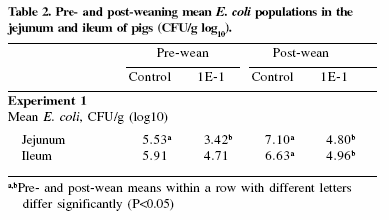
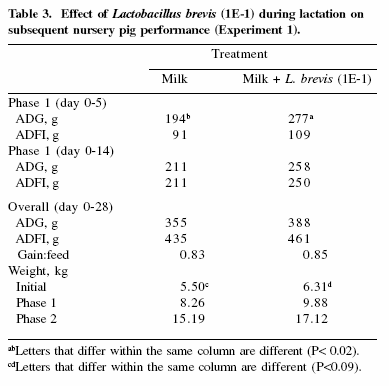
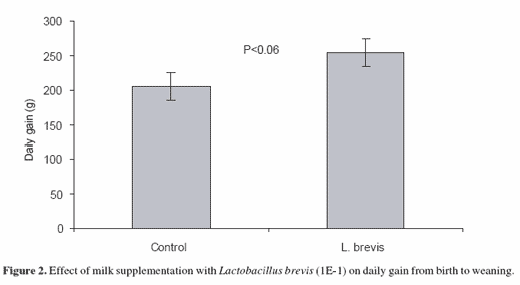
A second study to confirm these results has recently been completed. Beginning at farrowing, pigs were provided milk supplementation either with or without the addition of Lactobacillus brevis (1E-1) via an inline system using a cup dispenser for each litter. These treatments were continued during the nursery period, in which pigs that were administered 1E-1 via milk supplementation continued to receive 1E-1 through the watering system. Pigs supplemented with 1E-1 had greater ADG (P<0.05) during Phase 2 and in the overall nursery period (day 0 to 38), greater ADFI (P<0.05) during Phase 3 and the overall nursery period, and tended to have increased gain:feed (P<0.10) during Phase 3 (Table 4). In this study, 1E-1 supplementation resulted in a 1.58 kg improvement (P<0.01) in body weight at the end of the six-week nursery period compared to pigs not receiving 1E-1 (Figure 4). These data indicate that 1E-1 supplementation pre-weaning improves nursery performance and may provide a healthier intestinal environment.
Studies that I have summarized involve classical culture techniques. We are adapting procedures that allow quantitative determination of all the primary microbiological species in the gut microbiota using molecular techniques (Figure 5). The development of molecular-based methods that by-pass the need for culturing bacteria has led to a renaissance in microbial ecology studies. Molecular methods that utilize the Polymerase Chain Reaction (PCR) exponentially amplify copies of bacterial DNA to literally produce a billion copies of the original template without growing the bacteria. These methodologies have created the first opportunity for ecologists to gain a true representation of the microbial world as it would exist in natural environments. To examine the bacterial ecology of known and unknown bacteria, the most often used method is to PCR amplify the 16S rRNA/DNA genes from a mixed bacterial community. These highly conserved genes encode a portion of the bacterial ribosome found in every known bacterium. This amplified mix of gene sequences can be separated, sequenced and compared to the 16S rRNA/DNA database presently containing taxonomic data of over 85,000 bacterial sequences.
These studies suggest that the impact of gut microbes on performance in young pigs is greater than once thought. Other researchers have documented enhanced performance in growing/ finishing pigs associated with improved health and management. Pigs with minimal disease due to SEW, which were fed a series of non-limiting diets and reared in pens of three pigs (2.23 m2/pig), achieved 104 kg at 136 days of age and 120 kg at 151 days of age (Schinckel et al., 1995). Pigs raised on the original commercial farm, conventionally weaned with all-in, all-out production, required 184 days to attain 104 kg live weight. This dramatic effect of health is likely mediated by inflammatory cytokines or other systemic inflammatory effects in response to bacterial toxins. The overall effect is to down regulate muscle synthesis and growth. Schinckel et al. (2003) presented a review of current research on muscle endocrine, and immune regulation of growth. 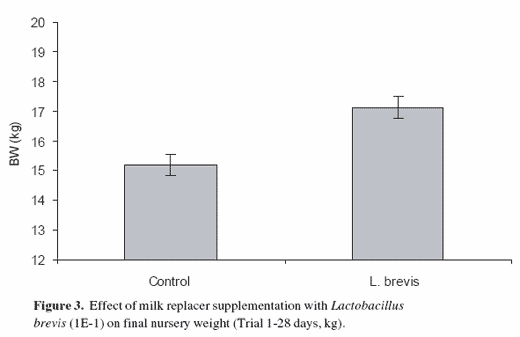

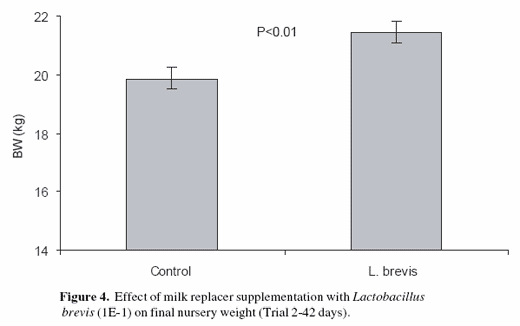
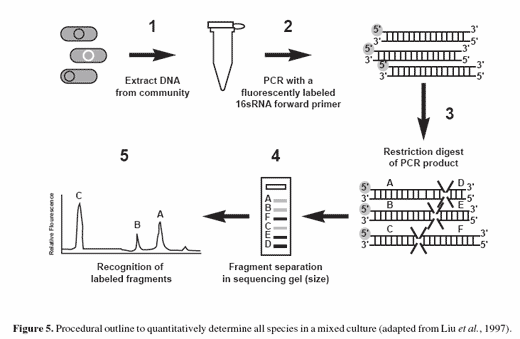
Bio-Mos®
Although prohibited in many European countries, the addition of antibiotic growth promoters to swine diets remains a common practice in the US, particularly to the diets of newly weaned pigs. However, there has been increasing pressure on the livestock industry to decrease or discontinue these additions because of the potential development of antibiotic resistance. The need for alternative methods to improve growth and efficiency of livestock production and to modulate the animal’s natural ability to fight disease has prompted the scientific investigation of several feed additives and their ability to positively alter immune function (Berg, 1998; Turner et al., 2001).
Supplementation of swine diets with mannan oligosaccharides derived from the yeast cell wall of Saccharomyces cerevisiae has the potential to provide an alternative to growth-promoting antibiotics. Mannan-based supplements have the ability to alter the microbial population in the intestinal tract. This modification seems to be accomplished by the ability of mannans to attach to mannose-binding proteins on the cell surface of some strains of bacteria, thereby preventing these bacteria from colonizing the intestinal tract by interfering with the binding of carbohydrate residues on epithelial cell surfaces (Spring et al., 2000).
Mannans have also been reported to alter immune function in swine (Kim et al., 2000), and this may be an additional mechanism by which mannans improve growth performance. The effects of Bio-Mos® on pig performance and immunocompetence was evaluated in five nursery pig trials conducted at the University of Arkansas.
A total of 412 pigs were included in the evaluation with 82 total observations (38 pens fed the basal diet, 15 pens fed 0.2% Bio-Mos®, and 29 pens fed 0.3% Bio- Mos®). In four of the five trials, Phase 1, Phase 2, and Phase 3 were defined as day 0 to 10 after weaning, day 10 to 24 after weaning, and day 24 to 38 after weaning, respectively. The fifth trial consisted of a 14-day Phase 1, and a 7-day Phase 2. During Phase 1, Bio-Mos® supplementation improved (P<0.02) feed efficiency compared to pigs fed the basal diet, whereas improvement in ADG approached significance (Table 5, P=0.11). Pigs supplemented with 0.3% Bio-Mos® had improved feed efficiency for the overall Phase 1 and 2 periods (P<0.03) when compared to those fed the control diet. During the first week of Phase 3, ADG (P<0.05) and feed efficiency (P<0.05) were improved in pigs fed Bio- Mos® when compared to pigs fed the basal diet. There were no differences (P>0.20) in lymphocyte proliferation between pigs fed Bio-Mos® and those fed the basal diet when data from the five trials were combined.
However, evaluation of immune assays conducted in the fifth trial revealed that Bio-Mos®- supplemented pigs had a greater proportion of lymphocytes in the peripheral blood (P<0.03), an increase (P<0.10) in the proportion of macrophages in the jejunal lamina propria, and an increase (P<0.05) in the phagocytic capacity of jejunal lamina propria macrophages compared to pigs fed the basal diet (P<0.05, Table 6). Data compiled from five experiments conducted at the University of Arkansas conclude that Bio-Mos® supplementation improves weight gain and feed efficiency in nursery pigs. Although the function of lymphocytes derived from peripheral blood was not affected by Bio-Mos® supplementation, Bio-Mos® did enhance innate immune function in the gastrointestinal system. 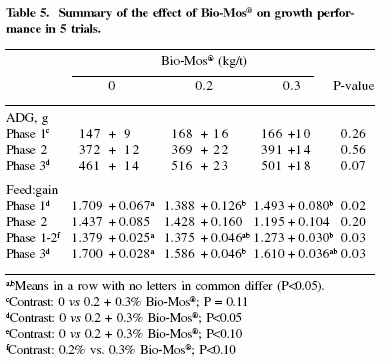
Our data indicate that Bio-Mos® alters the proportion and function of leukocytes isolated from the peripheral blood as well as the gastrointestinal tract of the weanling pig. One of the questions raised by the results of these studies with Bio-Mos® is; how can a non-digestible feed additive alter immune responses in the gastrointestinal tract and systemically in the pig? One possible mechanism is via the uptake of Bio-Mos® from the lumen of the gastrointestinal tract by M cells of Peyer’s patches. Peyer’s patches are organized lymphoid follicles located along the luminal surface of the small intestine. Dispersed throughout the epithelial layer of the Peyer’s patch are specialized epithelial cells, termed M (membranous) cells, which function to pinocytose and transport macromolecules from the intestinal lumen into the subepithelial tissue, delivering antigenic molecules to leukocytes within the Peyer’s patch. The extraction of Bio-Mos® from the lumen of the small intestine by the M cells of the Peyer’s patch and its exposure to the immune cells located there, may be the impetus for a cascade of immunomodulatory events that develop and enhance immune function, both locally in the gastrointestinal tract as well as systemically, as cells migrate out of the gastrointestinal tissue into the periphery. 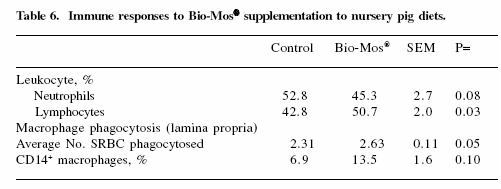
Because mannan oligosaccharides have been documented to alter bacterial populations within the intestinal tract (Spring et al., 2000), another explanation for the alterations in immune function observed in these studies may be from changes elicited in the enteric microbial population by the presence of mannans in the luminal environment of the intestinal tract. The microflora present in the gastrointestinal tract are known to be a factor in the development of the young pig’s immune system, both enterically and systemically (Gaskins, 1997), and the alteration of these microbial populations by Bio-Mos® could have an impact on the progression of immune system development.
NuProTM 2000
Pigs produced in conventional intensively managed swine production systems are routinely weaned at 19 to 21 days of age and as early as 10 to 14 days of age in off-site SEW systems. At this age, pigs are very sensitive to the source of dietary protein. Many dietary proteins produce allergic reactions in which diarrhea, reduced growth and increased mortality can occur (Bimbo and Crowther, 1992). Various protein sources have been tested in early-weaned pig diets in an attempt to overcome these problems and to decrease diet cost. Spray-dried plasma protein is a protein source that has consistently been shown to improve performance of early-weaned pigs when included in Phase 1 (day 0 to 14 post-weaning) diets at the expense of dried skim milk (Hansen et al., 1993; Kats et al., 1994; de Rodas et al., 1995), soybean meal (Fakler et al., 1993; Coffey and Cromwell, 1995; de Rodas et al., 1995), and whey (Hansen et al., 1993). Select grade menhaden fish meal has also been a widely utilized protein source due to a combination of consistent quality and competitive price. Demand for plasma protein is high and supply is limited, therefore plasma is an expensive protein source for nursery diets. Also, regulatory constraints that prohibit the use of plasma protein in many countries may affect the use of bovine plasma in the US. Similarly, increased demand and decreased supply of fish meal has resulted in increased price volatility and relatively high current prices.
Preventing intestinal damage or atrophy immediately post-weaning caused by reduced feed intake and lack of stimulation of the intestinal epithelium by ingested particles has been suggested as important in maintaining growth performance in nursery pigs (Cera et al., 1988; Dunsford et al., 1989). However, there are many other factors, including removal of beneficial factors from sow’s milk, diet form, stress, invasion by microorganisms, or introduction of allergenic compounds in the nursery diet, that may also contribute to intestinal atrophy. Glutamic acid and nucleotides may be important nutrient sources for maintaining gut integrity during the early nursery period.
NuProTM 2000 is a protein source high in crude protein (51 to 55%) and digestible amino acids that has potential as a possible alternative protein source in nursery diets. NuProTM is also high in glutamic acid and is an excellent source of nucleotides. Several animal-based specialty feed ingredients have been developed to compete against the animal plasma and fish meal market share. However, NuProTM is a vegetable-based peptide product which may have greater international market appeal compared to products originating from animal by-products and the high level of nucleotides may be uniquely beneficial to the early-weaned pig.
A study has been completed at the University of Arkansas involving a total of 216 pigs to evaluate the efficacy of feeding NuPro™ as an alternative to plasma protein in nursery pig diets (9 pens/treatment). Three dietary treatments were fed from day 0 to 7 after weaning (Phase 1) and day 7 to 21 after weaning (Phase 2) and were comprised of 1) a basal diet consisting of a complex nursery diet containing spraydried plasma protein devoid of NuProTM, 2) the basal diet with 50% of the plasma protein replaced by NuProTM, and 3) the basal diet with 100% of the plasma protein replaced by NuProTM. During Phase 3 (day 21 to 42 after weaning) a common diet was fed to groups previously receiving Treatments 1 and 2. Half of the pigs previously fed Treatment 3 were fed the common diet received by the Treatment groups 1 and 2; while the other half were fed a diet containing 1.3% NuProTM during the first week of Phase 3 (day 21 to 28) followed by the common diet for the remainder of the phase (day 28 to 42). During Phases 1 and 2, no significant differences were observed among the four dietary treatments with regard to ADG, ADFI, or G:F (Table 7). During the first week of Phase 3, pigs previously fed the basal diet containing plasma protein and fed NuProTM at the 50% replacement level had lower (P=0.07) ADFI than pigs previously fed NuProTM at the 100% replacement level and pigs fed NuProTM at 1.3% of the diet during the first week of Phase 3. This study indicates that NuProTM maybe used as an alternative to spray-dried plasma protein in nursery pig diets, and the removal of NuProTM from the diet does not result in decreased feed intake as is often the case with the removal of plasma protein. This study indicates that NuPro™ may be an effective replacement for plasma protein.
Organic selenium from yeast
Organic selenium offers several major opportunities to the feed/food industries. Although inorganic selenium (sodium selenite) has routinely been added to most animal diets, research has shown that about 60% of it is excreted in the urine. Organic selenium (selenium enriched yeast) is an effective source of selenium as it is more effectively retained in muscle, milk, and fetal tissues than inorganic selenium and less is excreted. Accumulation in tissues provides a selenium reserve that can be used under conditions of stress for additional synthesis of selenoproteins essential for counteracting adverse effects of free radicals. Organic selenium is also transferred into the egg more efficiently and into embryonic tissues in mammals via improved placental transfer when compared to sodium selenite. This provides the young animal with higher selenium stores, which can promote improved disease resistance. In addition to the benefits to livestock species, higher tissue levels of organic selenium may offer health benefits to consumers who choose Se-enriched animal products. Although somewhat controversial, increased selenium intake has been associated with reductions in cancer risks in epidemiological studies (Vogt et al., 2003), animal models (Popova, 2002) and chemopreventive studies (Combs et al., 2001; Clark and Marshall, 2001). Should additional studies underway prove conclusive, this presents the livestock and poultry industries with an opportunity to provide additional health benefits to the public consuming animal products.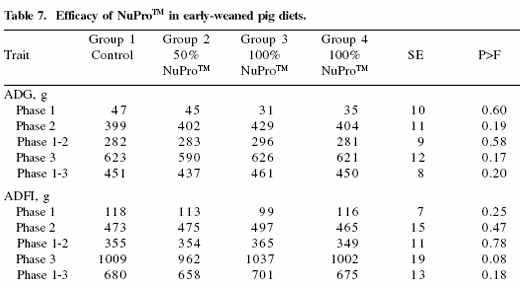
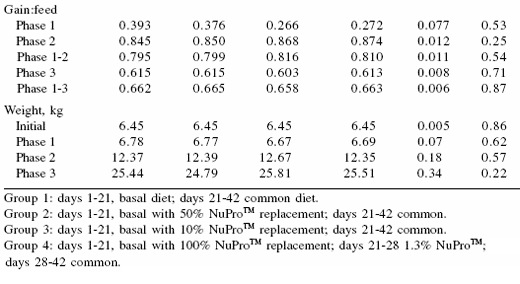
Environmental impact of concentrated animal feeding units
Another major problem facing the feed/food industry is the concentration of nutrients in modern livestock and poultry production systems. Northwest Arkansas contains the headwaters for two scenic rivers and is also the location of a major concentration of animal production, primarily poultry. Disposal of the concentrated animal waste, which accumulates in efficient production systems, in a manner that minimizes odor and optimizes nutrient utilization is an increasing problem facing the livestock and poultry industries in our state. Animal waste can be a valuable resource as an alternative source of fertilizer nitrogen (N), phosphorus (P), and potassium (K) in maintaining and restoring soil productivity. In fact, by improving ground cover, runoff volume and erosion may also be reduced. Conversely, application of animal manure at rates greater than a crop can utilize has been shown to result in nitrate (NO3) movement through the soil into ground water and can result in an excessive rise in soil P levels, leading to increased phosphorus runoff. This can be a problem since phosphorus is normally the limiting nutrient for eutrophication in freshwater systems. Odor and nutrient problems can both be exacerbated by excessive nutrient buildup in lagoons/holding ponds that have not been dewatered in a timely manner.
With the initial population of the new University of Arkansas 2000 head/year finishing facility, a decision was made to demonstrate the use of dietary phytase addition to substantially reduce phosphorus production in swine manure without affecting swine performance or profitability. Facilities were constructed to permit production of two types of manure that was stored in holding ponds. Pigs placed in half of the pens received normal phosphorus diets devoid of phytase and pigs placed in the other half of the facility received diets with reduced phosphorus supplemented with phytase. The holding ponds were managed by emptying the shallow pit under the pigs on each diet on a weekly basis and recharging the pit with effluent from the top of the holding pond. This simulated the management of a pull-plug waste disposal system and allowed the accumulation of the two types of manures for application on watersheds.
Table 8 provides the average total and soluble phosphorus analysed in the holding ponds. The 24.8% reduction in total phosphorus is consistent with the magnitude of reduction observed in phosphorus balance studies with pigs to determine the magnitude of reduction of phosphorus expected by feeding reduced phosphorus diets with added phytase. The magnitude of reduction in soluble phosphorus was only 8.95%, suggesting that a higher percentage of the phosphorus from pigs fed phytase was in the soluble form. This is consistent with other observations that phytase increases soluble phosphorus in manure. 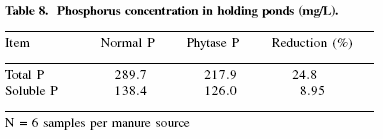
The reduced risk of phosphorus runoff from watersheds receiving manure from phytase-treated pig diets in relation to manure from pigs fed normal phosphorus, non-phytase diets was also demonstrated. Concern over water quality near animal production facilities is primarily with regard to transport of excessive amounts of N and(or) P from the animal waste.
A third watershed evaluated the efficacy of aluminum chloride (AlCl3) addition to swine manure on runoff. Shreve et al. (1995), Moore et al. (1995) and Smith et al. (2001) recommended treatment of manure with aluminum chloride as a means of reducing both P and NH3 losses. Runoff of nutrients was compared to a watershed that received no manure or fertilizer. The watershed sites were designated:
1. No manure or fertilizer application
2. Phytase manure: Low P diet, high N, but low P loading, lower risk of P runoff.
3. Normal manure: Normal P diet , high N and P loading on pasture, high risk of P runoff.
4. Phytase manure: Low P diet, high N, but low P loading, aluminum chloride added to reduce soluble phosphorus and lower risk of P runoff.
Manure was transported from the respective holding basins and applied to two separate pastures in multiple applications at rates equivalent to a target of 150 lb N/acre/year. Manure from pigs fed the reduced phosphorus diet with added phytase was also treated with aluminum chloride by adding 0.75% aluminum chloride to the manure prior to application. This was added to a third watershed at the same application rate used in the other watersheds. A fourth watershed had no manure or fertilizer added. A total of three applications were made during the project. A ‘Small In-field Runoff Collector’ system was used to collect runoff water. Samples from each watershed and storm event were composited and analyzed for total Kjeldahl N, total P, soluble P, NH3-N, NO3-N, copper and zinc.
Total runoff data are presented in Table 9. The watershed that received no manure or fertilizer produced the greatest total runoff with 191,344 liters. This might be expected since reduced forage cover may increase runoff. The watershed receiving the normal phosphorus manure was next with 179,028 liters followed by the watershed receiving AlCl3 treated manure from pigs fed phytase (162,418 liters). The watershed receiving untreated manure from pigs fed phytase had the lowest total runoff of 112,826 liters. 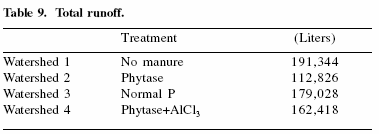
The total nutrients applied to the watersheds in the three applications are presented in Table 10. The application of total N was approximately 150 lbs of total N/acre/year. The addition of aluminum chloride to the swine manure also substantially reduced the soluble phosphorus at the time of manure application, as expected. 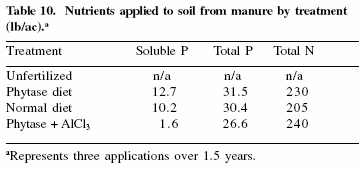
The mass of soluble and total P lost from the watershed fertilized with normal manure was greater when compared to the runoff in the unfertilized watershed or watersheds fertilized with phytase manure or phytase manure with AlCl3 (Table 11). This total mass of P loss in the watershed fertilized with normal manure also represented the greatest percentage of applied total P lost among the watersheds (5.4 vs 3.6 and 4.9% for the watersheds treated with phytase manure and phytase with AlCl3, respectively). Application of manure from pigs fed phytase, with or without treatment with AlCl3, reduced the mass of soluble and total P runoff. In fact, the watershed treated with phytase manure produced the lowest total P and percentage of soluble and total P runoff among the watersheds, even lower than that observed in the unfertilized watershed.
It should be noted, however, that runoff volumes were variable between watersheds, which had an impact on the total mass of nutrients lost from the runoff events. When comparing the mass of nutrients applied to that which was lost through runoff, it is important to note that the vast majority of nutrients remained within the watershed. In general, more than 90% of the nutrients applied remained in the watershed. The exceptions to this are the percentage of soluble P lost from the watershed receiving the normal P manure (12.7%) and the percentage of soluble P lost from the watershed receiving the phytase manure with AlCl3 (60.6%). A higher percentage of soluble nutrients were lost through runoff, because the soluble fraction is fairly dynamic, and is also more susceptible to runoff losses than the total fraction. There was more soluble P removed from the phytase manure with AlCl3 watershed than was applied from the manure, most likely due to the natural loss of soil P as seen in the unfertilized watershed. The N lost from these watersheds was a very small fraction of what was applied, ranging from 0.6% to 1.2%. 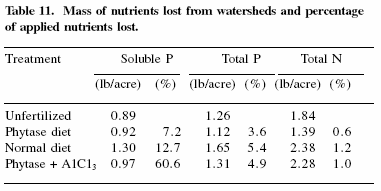
Zinc concentrations from runoff were very low (Figure 6). Manure had no apparent impact on metal runoff when applied as a fertilizer resource to the watersheds. Copper concentrations in runoff were also very low, in the ppb range, and were not affected by the addition of manure to the watersheds (Table 12). 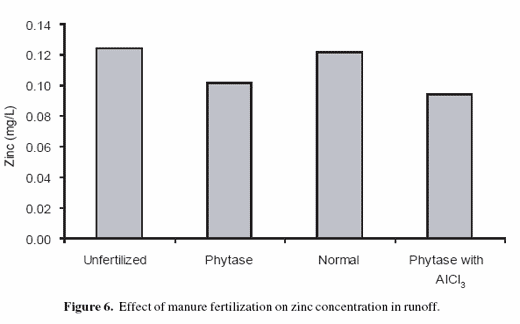
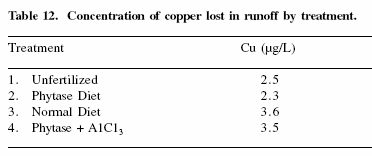
One of the objectives of this project was to conduct a phosphorus and nitrogen budget for the farm. A total of 8,222 lb of phosphorus was delivered to the farm and an estimated 2,507 lbs (30.5%) was removed in pigs marketed or retained in pigs kept as replacement breeding stock (Table 13). A total of 1,616 lbs (19.6%) was spread on 88 acres for an average application rate of over 12 lbs of total P/acre/yr, which exceeds the P needed for forage production for grazing or hay. The amount of total N delivered to the farm was 40,839 lb (Table 14). An estimated 11,608 lbs (28.60%) was removed in pigs marketed or retained in pigs kept as replacement breeding stock. A total of 3,655 lb. (8.94%) was spread on 88 acres for an average maximum application of 41.50 lbs of N/acre. If one obtained the expected ammonia loss from volatilization of 25%, then the actual applied N would be about 31 lb/acre, which is probably below the crop needs for either the bermuda or fescue pastures where manure was applied. The residual N is most likely much less than the calculated residual since ammonia volatilization from the production facility and holding ponds is likely to be substantial. 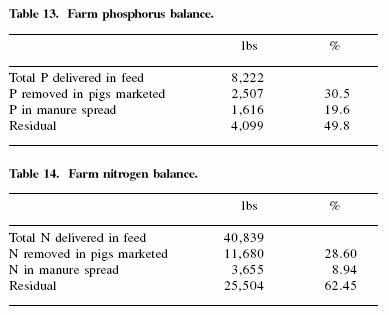
This study demonstrates that even with judicious management, phosphorus in the soil accumulates with application of swine manure based on plant requirements for N in forage-based systems. Construction of new production facilities should only be considered after development of nutrient management plans ensuring application of nutrients that do not exceed crop needs. Technologies to further reduce phosphorus in manure would reduce the land base needed for concentrated animal production facilities.
In areas where nutrient excesses exist, progress is being made in developing technologies to address the problem and some are even receiving praise for delivering both environmental and economic benefits. Singled out in the popular press recently is the manure management system in the Chino Basin in Southern California, which utilizes a digester to convert dairy manure into fertilizer and methane used for power generation. Smithfield Foods is constructing a $20 million system to convert swine manure into liquid methanol to be used in the production of biodiesel. Success of these systems is critical for maintaining good relationships in communities with large livestock production facilities. Why would every state not want to have a $7 billion poultry industry like Arkansas?
Conclusions
In summary, it appears there will be increased emphasis on food safety that will require dramatic changes in the way national and international feed/ food companies operate. This has benefits not only from a food safety standpoint, but as we develop a better understanding of controlling microorganisms in the environment, we may also tremendously improve animal health and performance and should have a number of alternatives to antibiotics. The impact of an animal’s interaction with microorganisms in the environment on gain and efficiency is even greater than once thought. Finally, it is evident that environmental and animal welfare issues will have increasing influence on decision making.
References
Bimbo, A.P. and J.B. Crowther. 1992. Fish meal and oil: Current uses. J. Am. Oil Chem. Soc. 69:221.
Bolduan, G. 1999. Feeding weaner pigs without infeed antibiotics. In: Biotechnology in the Feed Industry. Proceedings of Alltech’s 15th Annual Symposium. (T.P. Lyons and K.A. Jacques (eds). P 223-230.
Cera, K. R., D. C. Mahan, R. F. Cross, G. A. Reinhart, and R. E. Whitmoyer. 1988. Effect of age, weaning and post-weaning diet on small intestinal growth and jejunal morphology in young swine. J. Anim. Sci. 66:574-584.
Clark, L. C. and J. R. Marshall. 2001. Randomized, controlled chemoprevention trials in populations with very high risk for prostate cancer. Elevated prostate-specific antigen and high-grade prostatic intraepithelial neoplasia. Urology 57:185-7.
Coffey, R. D. and G. L. Cromwell. 1995. The impact of environment and antimicrobial agents on growth response of early-weaned pigs to spray-dried porcine plasma. J. Anim. Sci. 73:2532.
Combs, Jr., G. F., C. L. Clark and B. W. Turnbull. 2001. An analysis of cancer prevention by selenium. Biofactors 14: 153-9.
de Rodas, B. Z., K. S. Sohn, C. V. Maxwell, and L. J. Spicer. 1995. Plasma protein for pigs weaned at 19 to 24 days of age: effect on performance and plasma insulin-like growth factor I, growth hormone, insulin, and glucose concentrations. J. Anim. Sci. 73:3657.
Dunsford, B. R., D. A. Knabe and W. E. Haensly. 1989. A comparison of dietary soybean meal on the microscopic anatomy of the small intestine in the early-weaned pig. J. Anim. Sci. 67:1855-1863.
Elam, T. E., 2004. Meeting growing meat demand for the future while protecting environment will be a challenge. Feedstuffs. 76(No. 4):23-28.
Fakler, T. M., C. M. Adams, and C. V. Maxwell. 1993. Effect of dietary fat source on performance and fatty acid absorption in the early-weaned pig. J. Anim. Sci. 71(Suppl. 1):174(Abstr.).
Gaskins, H. R. 1997. Immunological aspects of host/ microbiota interactions at the intestinal epithelium. In: Mackie, R. I., White, B. A., Isaacson, R. E. (Eds.), Gastrointestinal Microbes and Host Interactions, Vol. 2, Chapman and Hall, New York, pp. 537-587.
Gaskins, H. R.. 2001. Intestinal bacteria and their influence on swine growth In: Swine Nutrition 2nd Edition. Austin J. Lewis and Lee L. Southern (Ed.). P 585-608.
Hansen, J. A., J. L. Nelssen, R. D. Goodband, and T. L. Weeden. 1993. Evaluation of animal protein supplements in diets of early-weaned pigs. J. Anim. Sci. 71:1853.
Jin, L. Z., Y. W. Ho, N. Abdullah, S. Jalaludin. 1998. Growth performance, intestinal microbial populations, and serum cholesterol of broilers fed diets containing Lactobacillus cultures. Poultry Science. 77:1259-1265.
Johnson, R.W. 1997. Explanation for why sick pigs neither eat well nor grow well. Proc. Carolina Swine Nutr. Conf. P. 49.
Katouli, M., L. Melin, M. Jensen-Waern, P. Wallgren, and R. Mollby. 1999. The effect of zinc oxide supplementation on the stability of the intestinal flora with special reference to composition of coliforms in weaned pigs. J. Appl. Microbiol. 87:564-573.
Kats, L. J., J. L. Nelssen, M. D. Tokach, R. D. Goodband, J. A. Hansen, and J. L. Laurin. 1994. The effect of spray-dried porcine plasma protein on growth performance in the early-weaned pigs. J. Anim. Sci. 72:2075.
Liu, W. T., T. L. Marsh, H. Cheng and L. J. Forney. 1997. Characterization of microbial diversity by determining terminal restriction fragment length polymorphisms of genes endocing 16S rRNA. Appl. Environ. Microbiol. 63:4516-4522.
Maxwell, C. V. and K. S. Sohn. 1999. The Pros and Cons of SEW System. AJAS. Vol 12 (No. 2):226- 232.
Parrott, T. D., T. Harbolt, T. Rehberger, W. White, and C. Maxwell. 1994. Characterization of the predominant lactobacilli isolated from the gastrointestinal tract of post-weaned pigs. 93rd General meeting of the American Society of Microbiology, Las Vegas NV.
Patience, J.F., H.W. Gonyou, D. L. Whittington, E. Beltranene, C.S. Rhodes, and A. G.Van Kessel. 1997. Evaluation of site and age of weaning on piglet growth performance and postweaning behavior and on sow productivity. Prairie Swine Center Inc., Saskatoon, SK, Canada. Monograph No. 97-01.
Popova, N. V., 2002, Perinatal selenium exposure decreases spontaneous liver tumorogenesis in CBA mice. Cancer Lett. 179:39-42.
Savage, D. C. 1987. Factors affecting the biocontrol of bacterial pathogens in the intestine. Food Technology. 41:82-87.
Schinckel A. P., Clark LK, Stevenson G, Knox K, Nielsen J, Grant A, Turek JJ, and Hancock D. 1995. Effects of antigenic challenge on growth and composition of segregated early-weaned pigs. Swine Health and Production 3(6):228-234.
Schinckel A. P., M. E. Spurlock, B. T. Richert, W. M. Muir and T. E. Weber. 2003. Proceedings European Association for Animal Production, Rome Italy, August, 2003.
Spring, P. 1999. The move away from antibiotic growth promoters in Europe. In: Biotechnology in the feed industry. Proceedings of Alltech’s 15th Annual Symposium. T.P. Lyons and K.A. Jacques (editors) P173-184.
Spring, P., C. Wenk, K. A. Dawson, and K. E. Newman. 2000. The effects of dietary mannanoligosaccharides on cecal parameters and the concentrations of enteric bacteria in the ceca of salmonella-challenged broiler chicks. Poult. Sci. 79:205-211.
Vogt, T. M., R. G. Ziegler, B. I. Graubard, C. A. Swanson, R. S. Greenberg, J. B. Schoenberg, G. M. Swanson, R. B. Hayes and S. T. Mayne. 2003. Serum selenium and risk of prostate cancer in U. S. blacks and whites. Int. J. Cancer. 103:664-70.
Wilson, M, 1995. Segregated early weaning. Pig Lett. 15:17-20.
The developed countries are talking about traceability of food. Processed packaged consumer goods, with labels indicating batch number. Cattle with electronic tags to determine which ranch the live animals are coming from and which company and from what plant it is processed. And the author is trying to be sure that if there is a problem in the food; the cause of the contamination is not from the feeds. This is a big leap into the improvement in Food Safety and Quality. Thanks to advances in feed processing technology.







.jpg&w=3840&q=75)